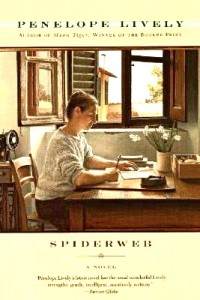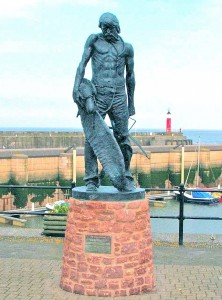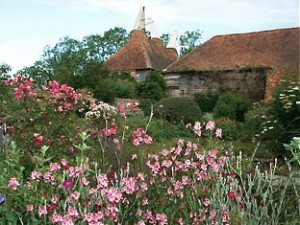Note: Penelope Lively has been shortlisted for the Booker Prize three times and is WINNER of it once, in 1987, for Moon Tiger.
“Like most people [Stella] felt ambushed by time – but since it had to be, there were certain advantages, she saw. The old and the young are washed to the margins of life – unessential and dependent. They share only the opportunity for untrammelled observation. And for Stella observation had been her way of life.”
 Setting her novel at the end of the twentieth century, Penelope Lively begins Spiderweb (1998) by presenting a sociological picture of the west of England and the once-remote counties of Somerset, Devon, and Cornwall, which are now attracting new residents from “outside.” A letter from Richard Faraday to Stella Brentwood regarding a property in Kingston Florey in nearby Somerset describes a cottage for sale and its pluses and minuses, and indicates that Richard has been helping Stella find such a property to purchase. We know nothing about either of them except that Stella was best friend of Richard Faraday’s wife Nadine from their college days. Gradually, the reader learns more about Stella, a sixty-five-year-old, newly retired social anthropologist and teacher, who filters all the impressions one gains about the village and its people through her own experience. When she buys this cottage, she approaches her new village not as a new member of the community, but as an academic and specialist in social structures.
Setting her novel at the end of the twentieth century, Penelope Lively begins Spiderweb (1998) by presenting a sociological picture of the west of England and the once-remote counties of Somerset, Devon, and Cornwall, which are now attracting new residents from “outside.” A letter from Richard Faraday to Stella Brentwood regarding a property in Kingston Florey in nearby Somerset describes a cottage for sale and its pluses and minuses, and indicates that Richard has been helping Stella find such a property to purchase. We know nothing about either of them except that Stella was best friend of Richard Faraday’s wife Nadine from their college days. Gradually, the reader learns more about Stella, a sixty-five-year-old, newly retired social anthropologist and teacher, who filters all the impressions one gains about the village and its people through her own experience. When she buys this cottage, she approaches her new village not as a new member of the community, but as an academic and specialist in social structures.
Stella has never married, not because she did not have opportunities but because she has been completely driven by her interests in other cultures and her desire to stay on the move,  professionally. Excerpts from her diaries, including one from her stay in a small village in Egypt in 1964, suggest her approach: “My many expensive years of education have left me quite unequipped for life in this mud village with two transistor radios, one moped, one petrol-driven engine and two hundred people, many of whom cannot write their names. What it has given me is the urge and the ability to cast a cold eye upon them and their way of life. Do I find this uncomfortable? Of course.” The parallels to the life about to unfold for her in Kingston Florey are obvious.
professionally. Excerpts from her diaries, including one from her stay in a small village in Egypt in 1964, suggest her approach: “My many expensive years of education have left me quite unequipped for life in this mud village with two transistor radios, one moped, one petrol-driven engine and two hundred people, many of whom cannot write their names. What it has given me is the urge and the ability to cast a cold eye upon them and their way of life. Do I find this uncomfortable? Of course.” The parallels to the life about to unfold for her in Kingston Florey are obvious.
Other contrasts evolve between Stella’s past life and family background, her education, her friendships, and her professional excitements and the lives of her neighbors: old Mr. Layton, born within a mile of where he now lives in a “stumpy cottage of cob and thatch”; Stan, the odd job man; Tory and Linda, busy IT consultants who live with their kids in a neighboring cottage, but only on weekends; Miss Clapp at the Animal Rescue Center, who tries to find the perfect dog for Stella; and especially her next-door neighbors, the Hiscox family. Mother Karen Hiscox gives new definition to martinet, a pathological control freak who terrorizes her totally ineffective husband, her disabled mother, treated almost as a prisoner, and her teenage sons, who have problems of their own. The boys run wild whenever they can escape their mother’s clutches, and in their paranoia they see Stella’s interest in them and their activities as hostile. Stella, however, continues to believe that “We st Somerset would cheerfully bare its soul to her…She had only to get talking at a bus stop or supermarket check-out, share a table in a pub, stop to chat at a filling station. Her credentials were instantly apparent: agreeably spoken, no spring chicken, origins uncertain, but that’s what you expect these days.”
st Somerset would cheerfully bare its soul to her…She had only to get talking at a bus stop or supermarket check-out, share a table in a pub, stop to chat at a filling station. Her credentials were instantly apparent: agreeably spoken, no spring chicken, origins uncertain, but that’s what you expect these days.”
The internet has yet to make its appearance in Kingston Florey, and, now that she has retired and become a homeowner, the independent Stella must find her excitement and mental stimulation in her everyday life in the community, in her phone calls from friends, and in her memories of the past, including past loves. She tries hard, but her brain will not quit long enough for her to allow her emotions to flourish. She gets a dog from the rescue agency, but the dog adores her and will hardly let her out of its sight, and she finds herself uncomfortable with such overwhelming love. She has a suitor, but she cannot disconnect him from what she k new of him in the past, even judging the elegant restaurant to which he takes her: “Food is more than meets the eye…it usually has ritual significance…[it says] the resources of civilization are available [here]. Mud and muck there may be, but immunity is available for those with discrimination.” She compares this man to the love of her life, a journalist she met in Malta many years ago, and the man in the Orkney Islands who begged her to marry him. Ultimately, she realizes that her life, like “this place” is a “web,”and its connections may also bind and destroy.
new of him in the past, even judging the elegant restaurant to which he takes her: “Food is more than meets the eye…it usually has ritual significance…[it says] the resources of civilization are available [here]. Mud and muck there may be, but immunity is available for those with discrimination.” She compares this man to the love of her life, a journalist she met in Malta many years ago, and the man in the Orkney Islands who begged her to marry him. Ultimately, she realizes that her life, like “this place” is a “web,”and its connections may also bind and destroy.
However annoying and difficult Stella might be to know in “real life,” she is earnest in her personal (though perhaps flawed) approach to life, and naive about how to connect with her feelings. She is even reluctant to admit she has feelings, but she recognizes that something is missing from her life, despite all her professional success. She cannot help remembering admonitions from people who have been close to her, such as Nadine, who has told her, “You’re the cat that walks by himself. You’re on the edge always, looking on. Interested. But…Detached…You’re not like the rest of us. How do you do it?”
 The author, in creating a gossipy and initially cheerful commentary on village life, makes us empathize with Stella, even as we are ready to throttle her, sympathize even as we recognize she is perhaps hopelessly obtuse. We see her actions with a kind of dark humor, even as we may feel guilty for feeling judgmental about her. The reader recognizes elements of foreshadowing given by the author and understands many of the social issues which underlie the behavior of the local people around her, but Stella, the anthropologist, is not privy to this information and has no way of ever learning it. Ironies, such as these, give the story a kind of resonance and universality which broaden the scope far beyond the limitations of Kingston Florey and offer commentary on what it takes to be a “successful” person. Stella, at sixty-five, has squandered her chance to experience a full life, at least by the standards of most of the rest of the world, and whether she is or can be truly happy is not clear. Whether or not she really cares is an even bigger question.
The author, in creating a gossipy and initially cheerful commentary on village life, makes us empathize with Stella, even as we are ready to throttle her, sympathize even as we recognize she is perhaps hopelessly obtuse. We see her actions with a kind of dark humor, even as we may feel guilty for feeling judgmental about her. The reader recognizes elements of foreshadowing given by the author and understands many of the social issues which underlie the behavior of the local people around her, but Stella, the anthropologist, is not privy to this information and has no way of ever learning it. Ironies, such as these, give the story a kind of resonance and universality which broaden the scope far beyond the limitations of Kingston Florey and offer commentary on what it takes to be a “successful” person. Stella, at sixty-five, has squandered her chance to experience a full life, at least by the standards of most of the rest of the world, and whether she is or can be truly happy is not clear. Whether or not she really cares is an even bigger question.
ALSO by Penelope Lively: MOON TIGER, HOW IT ALL BEGAN, THE PURPLE SWAMP HEN
Photos, in order: The author’s photo appears on http://www.listal.com
Stella and the love of her life once spent a weekend in the nearby town of Watchet, shown here: http://exmoorencyclopedia.org.uk
Watchet is near the former home of Samuel Taylor Coleridge, whose “Rime of the Ancient Mariner” is memorialized in this statue by Alan B. Herriot, showing the mariner holding the dead albatross: http://4umi.com
Stella had thoughts of creating a border of diascia in part of her overgrown backyard, as her friend Nadine once did. This photo by Carol Casselden shows such a border. http://www.gapphotos.com
Note: The fictional town of Kingston Florey may have been inspired by the real Somerset towns of Combe Florey, home of Evelyn Waugh (and where Auberon Waugh still lives), and Kingston St. Mary, only four miles away.
